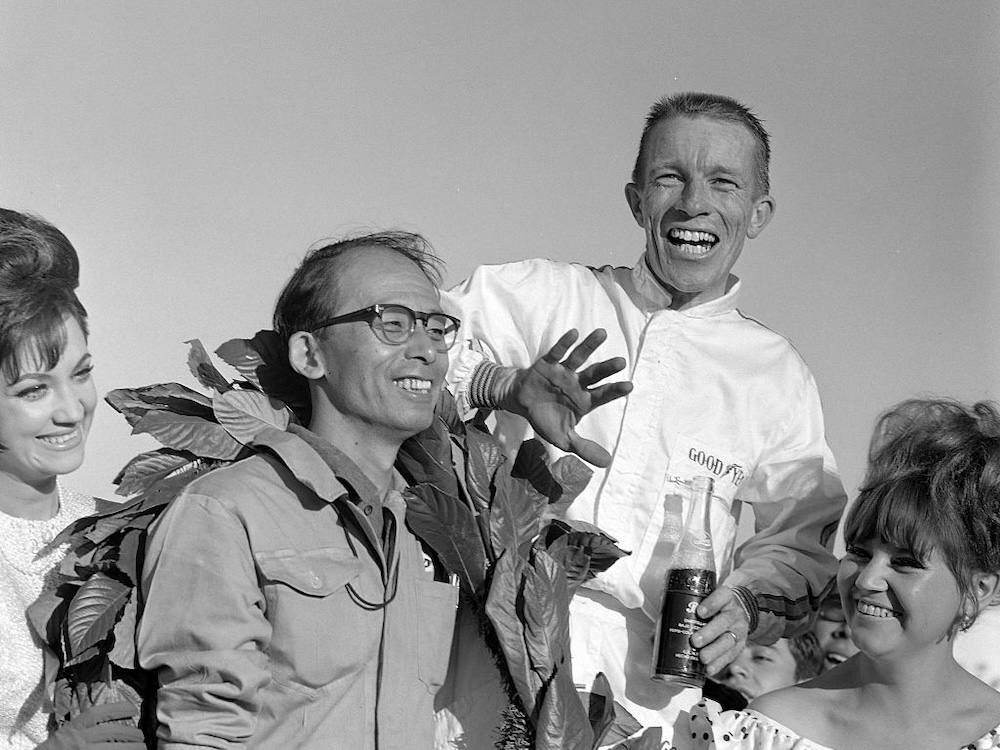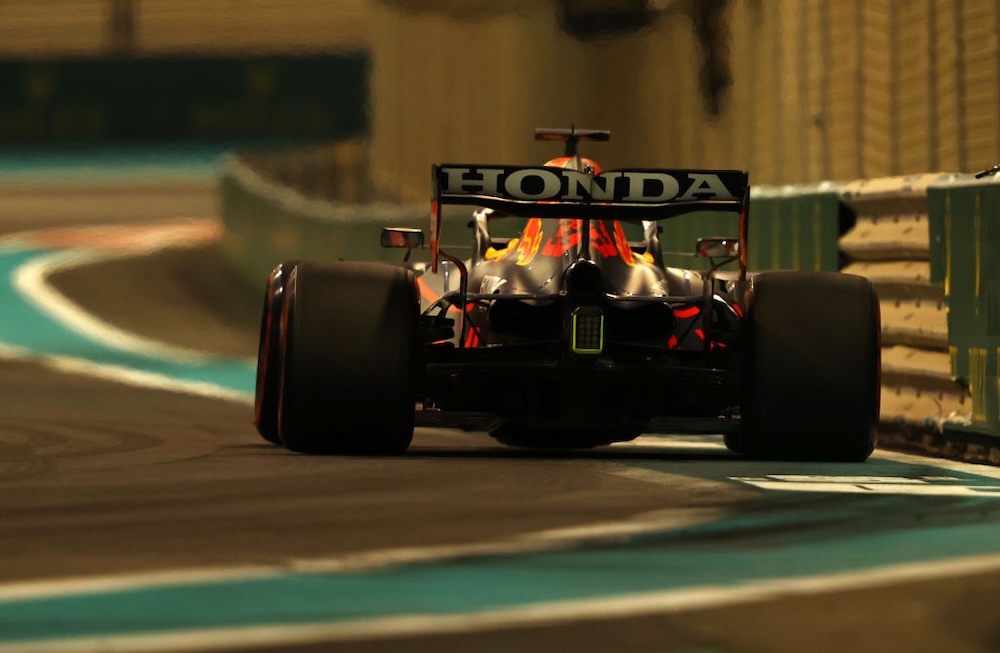The very first thing you discover is its magnificence, however the very first thing you’re feeling is Actually Watch out of noise.
It is Sunday morning at Autodromo Hermanos Rodríguez. Hours later, Lando Norris would win the Mexican Grand Prix, changing into the primary driver in hybrid-era F1 historical past to vary the championship lead throughout the closing 5 races.
Sixty years in the past this weekend, Richie Ginther held his personal masterclass on the identical venue, main the 1965 Mexican Grand Prix from begin to end. This was Honda’s first F1 victory in its quick historical past. And now, sitting in a particular pit field simply in entrance of Hiroki Tsunoda’s storage is the automobile during which Ginther did it, a Honda RA272, dwarfed by the RB21 within the stands only a few ft behind.
The outside is just not very advanced, even by the requirements of the time. The minimalist really feel is accentuated by the cool Japanese flag-inspired livery, which is nearly utterly white apart from a big pink circle throughout the nostril.
Inside minutes, Tsunoda can be nestling into the tiny cockpit and sending the RA272 out onto the monitor to commemorate a significant milestone in Honda’s motorsport historical past. Meaning it is time to begin. A devoted crew of mechanics, wearing period-style gear, take away the engine cowl to disclose one of many automobile’s trademark options. At a time when V8s had been thought of the usual (though Ferrari typically raced flat-12s, together with in Mexico ’65), Honda opted for a transversely mounted 1.5-liter V12. It is a configuration that Honda engineers hope will ship extra peak energy due to smaller transferring components and better rotational speeds. Honda’s V12 was the gold customary of F1’s 1.5-litre period.
The mechanics milled round for some time, then out of the blue the pit lane was full of a sequence of loud metallic thuds because the engine, known as RA272E, cleared its throat and set free a distorted trumpet. A number of mechanics from the Ferrari storage subsequent door came visiting with cell telephones out to document video. F1 vehicles are actually exponentially extra subtle, however some issues are past expertise.
As soon as the engine cowl is again on and Tsunoda sits in place, the engine roars just a few occasions as I feather the throttle and the RA272 heads down the pit lane, following the tracks of its 60-year-old wheels.
The 1965 Mexican Grand Prix was an odd race. This was the final of the season and the final for the 1.5-liter engine method forward of the transition to 3-liter laws in 1966. The vehicles on the grid can be outdated as quickly as they crossed the end line, and with the World Championship already settled in Jim Clark’s favor at Monza two races earlier (regardless of Clark dropping out with a gas pump downside), one report that day instructed that not all groups arrived in Mexico with their eyes absolutely on the ball.
However Honda got here ready for Bear. Ginther and compatriot Ronnie Bucknam held extra follow classes from 6 a.m. to 9 a.m. for 3 days earlier than the primary official follow session because the Honda crew, visiting the 7,000-foot circuit for the primary time, struggled with gas mixtures and tried to resolve issues with the injection system.
As soon as the ‘correct’ operating began, the RA272 was quick, with each drivers posting laps within the 1 minute 57 second to 1 minute 58 second vary. This was lap document territory on the time. At one level the drivers swapped vehicles and each improved their occasions on the opposite automobile. For the remainder of the sphere, the expertise of getting dusted down the lengthy primary straight was a harbinger of issues to return.
The subsequent day was hotter, however the Honda’s tempo was nonetheless good and each drivers had been fast once more after altering vehicles, with Ginther in third place on the finish of qualifying with a time of 1 minute 56.48 seconds, 0.31 seconds off Clark’s pole time and simply 0.07 seconds behind Dan Gurney’s Brabham. Bucknum began 10th.
Clear visibility of Clark and Gurney’s monitor didn’t proceed till the primary nook. Ginther handed each of them initially and took the lead, which he held till the checkered flag, however not with out some scares. The charging Gurney progressively reduce his seven-second half-distance result in lower than 4 seconds, forcing Ginther to step up in response. The 2 males broke lap information a number of occasions, with Gurney lastly breaking the document with a time of 1 minute, 55.84 seconds. Nevertheless, it was a disappointing consequence. Ginther completed 2.89 seconds away from his rival, whereas third place Mike Spence was nearly a minute forward in his Lotus.
After the race, Honda crew supervisor Yoshio Nakamura despatched a message to the corporate’s headquarters in Tokyo: “Veni, vidi, viti,” the New York Occasions reported with a mediocre headline. “Ginther helps Honda. Victory in Mexico Metropolis is due to tuning.” – identified that the motive force who was as soon as described as “a contented little man with a vibrant future within the auto racing trade” is now “a contented little man with an ideal probability to turn into world champion”.

Ginther celebrates profitable the 1965 Mexican Grand Prix. This was the primary GP win for himself, Honda and Goodyear, however in Ginther’s case it will be his solely victory. Getty Photographs
Frank M. Clean, the Occasions’ pioneering motorsports author, was improper on that final level – Ginther’s first win was additionally his final, however Honda and Goodyear, who additionally received their first Grand Prix race, had far more success in retailer. This screaming little white automobile by no means raced once more, however it impressed many goals for its creators on the opposite facet of the world for many years to return.
“When Honda was a small firm, it was a really small firm. Our founder, Soichiro Honda, believed that with the intention to make our presence felt, we wanted to compete in top-category races,” stated Honda CEO Toshihiro Mibe, who was in Mexico for the sixtieth World Championship.th Anniversary final weekend.
For Honda, which began out as a bike producer, that meant entering into motorsport via the well-known Isle of Man TT race, making its debut in 1959 with the RC142 bike and profitable the Producer’s Staff Award. The race two years later was received by Mike Hailwood.
Having made his title on two wheels, Soichiro Honda’s subsequent objective was to do the identical on 4 wheels. In 1962, he determined to enter Formulation One. It was a daring alternative for a producer that had not but launched a street automobile. (It appeared in 1963).
“Everybody was stunned by this,” Mibe says. “The corporate workers had been amazed, and a 12 months later (Honda debuted in Germany in 1964) we received our first victory right here in Mexico.
“In 2026, we will likely be competing once more as a works crew. (Nevertheless) we’re going to change the crew. We’re going to introduce inexperienced vehicles.” (Ed.: Honda is at the moment partnering with Crimson Bull, however plans to turn into a works provider to Aston Martin subsequent 12 months).
In Mr. Mibe’s phrases, the phrase “once more” does the unglamorous heavy lifting. Like most producers, Honda’s manufacturing unit participation in F1 has been cyclical, with its final full works program lasting from 2015, when it initially partnered with McLaren, till switching to Crimson Bull – till 2021.

Honda’s final full manufacturing unit F1 program led to 2021 (pictured above), however they’ve continued to accomplice with Crimson Bull on powertrains. He’ll return as a works entry for Aston Martin subsequent 12 months. Bryn Lennon/Getty Photographs
Its resurgence comes at a time when justifying a worldwide motorsport program is far more sophisticated than in years previous. Soichiro Honda was in a position to get the inexperienced gentle for Honda’s first F1 program just because he wished it. At present, producers need to weigh apparent elements similar to price in opposition to broader company priorities (Honda’s earlier exit from F1 was pushed by a want to deal with zero-emission applied sciences similar to electrification and hydrogen), in addition to international issues similar to politics and the setting.
So whereas racing is in Honda’s DNA, really taking part in it’s an train in balancing Honda’s heritage and spirit in opposition to the truth of appearing within the broader pursuits of a multinational company.
“Subsequent 12 months we will likely be calling it the ‘fifth era’ (of racing),” Mibe stated. “We have joined, we have stop, we have joined once more subsequent 12 months…Every era of CEOs has stated racing prices some huge cash, so typically they stop to deal with the enterprise.
“However all of us at Honda acknowledge that we’ve this (racing) DNA. That is why we determined to carry this fifth era again into F1. We would like this era to be steady. That is why HRC (Honda Racing Company) is working by itself to deal with stability. And Mr. Watanabe.” (Edited by Koji Watanabe, HRC President and CEO) We put a number of effort into making that occur. ”
“The objective is to not create six generations,” Watanabe added with amusing.
Attaining this objective primarily requires controlling prices. HRC is actively working to develop its efficiency components division, however it’s going to take greater than that to cowl the massive prices required to be aggressive in F1.

The 1965 Mexican Grand Prix-winning Honda RA272 was the visitor of honor eventually weekend’s Mexican Grand Prix, the place it achieved its historic victory 60 years in the past. Colin McMaster/Getty Photographs
“F1 is the most costly race on the earth,” Mibe stated. “However we’re discussing laws to manage the sum of money we use. F1 is excessive expertise so we will not reduce it considerably. We have to preserve creating new expertise, so we have to discover a steadiness. It is tough to satisfy the associated fee cap, so we have to handle our assets to cope with that and keep aggressive. I feel that is going to be a brand new problem for us.”
On paper, Honda’s fifth era seems prefer it has all of the makings to be thrilling. Aston Martin has made a high-profile transfer to signal Adrian Newey, who has been main the event of the 2026 automobile, in preparation for a reset of F1’s technical laws. His arrival was the sharp tip of a broader improve of the crew’s design and engineering capabilities over the previous 12 to 18 months.
And Aston Martin’s just lately opened 400,000 sq ft AMF1 Staff Know-how Campus is a three-building facility in Silverstone that homes all the crew’s design, engineering and manufacturing assets, together with a brand new wind tunnel.
All of this must be taken under consideration earlier than contemplating Honda itself and the facility that the engine producer has already achieved with 89 wins, 223 podiums, 6 drivers’ championships and 6 constructors’ titles. (Moreover, he received three GPs as a full-entrant, with John Surtees profitable at Monza in 1967 in an Eric Broadley-designed ‘Hondra’ RA300, and following Ginther’s early success, Jenson Button introduced his RA106 to gentle on the 2006 Hungarian Grand Prix nearly 40 years later).
The reply to how all the potentialities on paper will translate to the circuit will start to be answered at Albert Park subsequent March. That is when the story begins as an upstart Asian producer, a Hollywood-born “completely happy little man” recognized for his expertise for testing and improvement, and cute vehicles with equally cute however superior engines put together for his or her subsequent chapter as Aston Martin Aramco Honda. The RA272 has fulfilled Soichiro Honda’s dream, however the firm he constructed nonetheless has far more to pursue.










